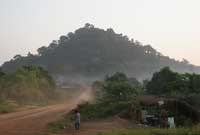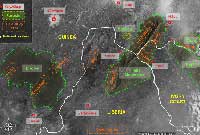HOME » Nimba
Nimba
The Nimba Mountains are located directly to the southeast of Bossou. Nimba is situated 230 km northwest of the Taï Forest, where a community of chimpanzees has been intensively studied since 1976 (Boesch, 1978).
The Nimba Mountains were established as a nature reserve in 1943 in Côte d'Ivoire, and in 1944 in Guinea. The nature reserve on the Côte d'Ivoire side is a "foret classée", under national ownership. The Guinea portion of the massif was accepted as a biosphere reserve in 1980, consisting of 17,130 ha. Both reserves now form a World Heritage Site,gazetted in 1981 for Guinea and in 1982 for Côte d'Ivoire.

The reserve extends over 220 sq. km and its highest peak, Mont Richard Molard, is at 1752m. The reserve on the Guinean side extends over 13,000 ha and 5,000ha on the Côte d'Ivoire side. The Nimba Mountains are cut up by deep, richly forested valleys. There is great topographical diversity, with valleys, plateaux, rounded hilltops, rocky peaks, abrupt cliffs and bare granite blocks, and the whole area constitutes a vast water catchment.
The Nimba Mountains have attracted the interest of scientists, including geographers, geologists, soil experts, botanists, zoologists and other specialists ever since the late 1930's (Kortlandt, 1986). Botanical, zoological and geological inventories have consequently been completed. The single most important work, a comprehensive and extensive record of the flora of the Nimba Mountains, was produced by Adam (1971-1983).
The Nimba Mountains are characterized by evergreen forest of medium altitude (Guillaumet & Adjanohoun, 1971). The region below 800 m is entirely covered by primary tropical forest and, above 800 m, where the mountain becomes steeper, the vegetation is interspersed with montane forest and patches of high terrestrial herbaceous vegetation and savanna.
Thus, there are three vegetation types which dominate the Nimba mountains (WCMC, 1982): 1) High altitude grassland near the summit and woody plants on the slopes, which are absent from the ridges; interspersed with patches of montane forest, dominated by Myrtaceae species, and Marantaceae and Zingiberaceae growth. 2) Savanna varying depending on the hardness and geological structure of the soil and supporting numerous herbaceous plant communities. The savanna is broken by gallery forests between 1,000m and 1,600m. Parinari excelsa is a dominant species above 1,000m, where there is also an abundance of epiphytes. 3) Predominantly primary forest, located mainly on the foothills and in the valleys, with dominant species including Triplochiton scleroxelon, Chlorophora regia, Morus mesozygia, Terminalia ivorensis, Lophira procera, Tarrieta utilis, Chrysophyllum gambia (perpulchrum), and Mapania spp. Drier mid-altitude forests with trees such as Triplochiton scleroxelon, Piptadeniastrum africanum, and Parkia bicolor are also found most commonly on the steeper slopes of the massif on the Cote d'Ivoire side. More than 2,000 plant species have been described from the Nimba region, and about 16 are thought to be endemic (Adam, 1971-1983). The area has, as a result, been identified as a center of plant diversity under the IUCN-WWF Plants Conservation Program (IUCN/WWF, 1988).
The Governments of both Guinea and Côte d'Ivoire have also organized since 1982 various missions and training conferences together with UNESCO in order to redefine the problems of ecosystem protection in the Nimba Mountain region (Pascual et al, 1988; Pascual et al, 1989). All these publications and missions have enormously contributed to scientific knowledge of various species of fauna (Lamotte, 1982) and flora (Fournier, 1987; Schnell, 1987), and soils found in the Nimba Massif. Since 2001, Fauna and Flora International has also supported Tripartite Meetings between Liberia, Guinea and Côte d'Ivoire in order to promote a more efficient and harmonious management of the entire Nimba Mountains' region.
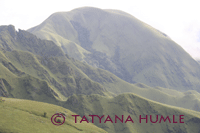
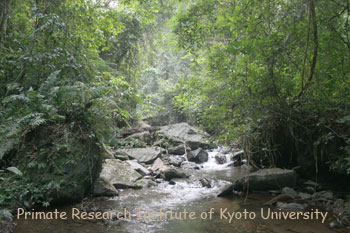

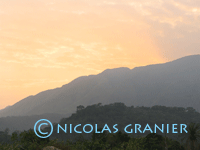
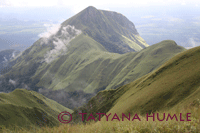
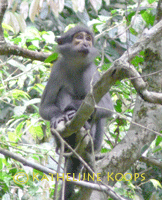
Sooty Mangabey (Cercocebus torquatus atys)
in Nimba
2006

A female chimpanzee in Nimba.
She has a very young infant on her belly (not visible).
2006



